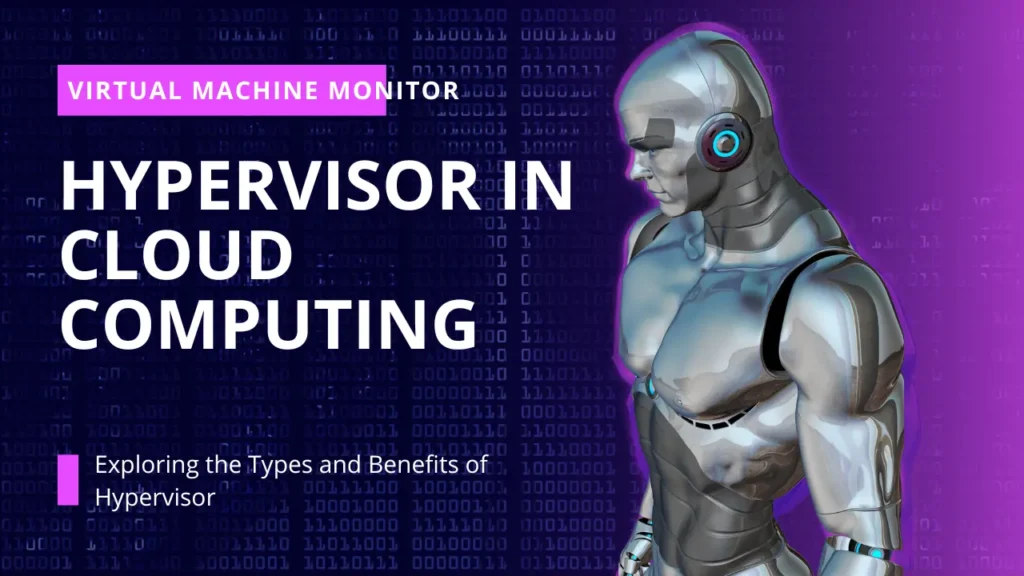What is a Hypervisor in Cloud Computing?
A hypervisor is a crucial element of cloud infrastructure that acts as an intermediary layer between the underlying hardware and the virtual machines. Its primary function is to create and manage these VMs, each of which operates independently, simulating an entire computer system. By doing so, hypervisors facilitate the isolation of workloads, allowing multiple VMs to coexist on a single physical server without interfering with one another.
Types of Hypervisors
There are two main types of hypervisors used in cloud computing: Type 1 and Type 2.
Type 1 Hypervisor (Bare-Metal)
Type 1 hypervisors, also known as “bare-metal” hypervisors, run directly on the host’s hardware without the need for a host operating system. They offer superior performance and efficiency as they interact directly with the hardware resources. Some well-known Type 1 hypervisor include VMware vSphere, Microsoft Hyper-V, and KVM.
Type 2 Hypervisor
Type 2 hypervisors, on the other hand, require a host operating system and operate as applications within it. They are more suitable for desktop and testing environments. Examples of Type 2 hypervisors include Oracle VirtualBox and VMware Workstation.
Benefits of Using Hypervisors in Cloud Computing
Hypervisors bring several advantages, making them indispensable to modern cloud infrastructures.
Enhanced Resource Utilization
With hypervisors, multiple VMs can share the same physical resources, such as CPU, memory, and storage, which leads to improved resource utilization. By efficiently allocating resources, organizations can maximize their investment in hardware infrastructure.
Cost Efficiency
By consolidating workloads onto fewer physical servers through virtualization, businesses can significantly reduce hardware and operational costs. Hypervisors enable the efficient utilization of resources, translating into cost savings in the long run.
Increased Flexibility and Scalability
Hypervisors allow businesses to adapt quickly to changing demands. Administrators can create, delete, or resize VMs as needed, enabling seamless scalability and flexibility in cloud deployments.
Improved Security and Isolation
Each VM operates independently of others, providing strong isolation between workloads. This isolation enhances security by containing potential security breaches within a single VM, preventing them from affecting other VMs or the underlying hardware.
Popular Hypervisors in Cloud Computing
Several hypervisors have gained prominence in cloud computing, each offering unique features and capabilities.
VMware vSphere
As one of the most widely used hypervisors, VMware vSphere provides robust virtualization features and management capabilities. It offers high availability, live migration, and resource management features, making it a preferred choice for many enterprises.
Microsoft Hyper-V
Microsoft Hyper-V is another popular hypervisor that seamlessly integrates with Windows environments. It provides extensive virtualization capabilities and integrates well with other Microsoft products and services.
KVM (Kernel-based Virtual Machine)
KVM is an open-source hypervisor that operates within the Linux kernel. It offers high performance, scalability, and security features, making it an option for Linux-based cloud deployments.
Xen
Xen is a powerful open-source hypervisor known for its efficient performance and strong security mechanisms. It is widely used in various cloud platforms and data centres.
Hypervisor Management and Orchestration
Effectively managing and orchestrating hypervisors is vital to maintain the stability and performance of cloud environments.
Virtual Machine Provisioning
Proper provisioning of virtual machines involves creating, configuring, and deploying VMs according to the specific requirements of applications and workloads.
Performance Monitoring and Optimization
Continuous monitoring of VM performance helps identify bottlenecks and resource constraints. Optimizing VM performance ensures smooth operations and enhances user experience.
Backup and Disaster Recovery
Implementing reliable backup and disaster recovery strategies is essential to protect crucial data and ensure business continuity during system failures.
Challenges and Limitations
Despite hypervisors’ many benefits, they also come with certain challenges and limitations.
Performance Overhead
Running multiple VMs on a single physical host can lead to performance overhead due to the virtualization layer. This overhead must be carefully managed to avoid performance degradation.
Security Risks
While hypervisors provide isolation, they are not invulnerable to security threats. A compromised hypervisor could potentially impact all VMs running on the same host.
Hypervisor Trends in Cloud Computing
The world of cloud computing is ever-evolving, and hypervisor technology is not exempt from innovation.
Containerization and Microservices
Containerization technologies, such as Docker and Kubernetes, have gained popularity for their lightweight and portable nature. They complement hypervisors and are widely used for deploying microservices.
Unikernels
Unikernels are specialized, lightweight operating systems designed to run a single application. They offer enhanced security and performance, making them a promising future trend.
Hybrid Cloud Integration
Hypervisors play a crucial role in integrating on-premises data centers with public cloud environments, enabling hybrid cloud setups that provide both scalability and control.
Future Prospects and Innovations
The future of hypervisors in cloud computing looks promising, with several innovations on the horizon.
Edge Computing and Hypervisors
As edge computing gains traction, hypervisors will play a pivotal role in enabling efficient resource management and orchestration at the network’s edge.
Hardware-Assisted Virtualization
Hardware-assisted virtualization technologies, such as Intel VT and AMD-V, will continue to advance, further enhancing VM performance and security.
Conclusion
In conclusion, hypervisors are indispensable tools in the world of cloud computing. They provide the necessary virtualization layer that enables the efficient allocation of resources, cost savings, and enhanced security. With various types of hypervisors available, organizations can choose the one that best suits their requirements and infrastructure. As the cloud computing landscape evolves, hypervisors will continue to adapt and innovate, driving the future of virtualization and resource management.
F.A.Q.s
Is a hypervisor the same as a virtual machine?
No, a hypervisor is a software or hardware component that enables creating and managing virtual machines (VMs). The hypervisor is an intermediary between the underlying hardware and the VMs.
Which type of hypervisor is more suitable for cloud environments? Type 1 hypervisors, also known as “bare-metal” hypervisors, are more suitable for cloud environments due to their direct interaction with the underlying hardware, offering superior performance and efficiency.
Can hypervisors improve security in cloud computing? Yes, hypervisors enhance security in cloud computing by providing isolation between VMs. This containment helps prevent security breaches from affecting other VMs or the underlying hardware.
What is VM sprawl, and how can it be prevented?
VM sprawl refers to the proliferation of underutilized VMs, consuming unnecessary resources. Proper VM management, monitoring, and regular audits can help prevent VM sprawl.
What is the significance of hardware-assisted virtualization?
Hardware-assisted virtualization technologies like Intel VT and AMD-V offload virtualization tasks to the processor, improving VM performance and security.



